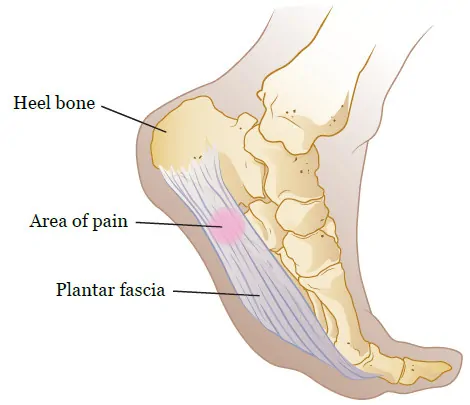How to Relieve Heel Pain: Plantar Fasciitis Causes & Treatment
Share on:
If you suffer from chronic heel pain, a probable explanation is plantar fasciitis. Plantar fasciitis is the most common cause of pain on the bottom of the heel, with some estimates suggesting that as many as 1 in 6 Americans may have this painful condition of the foot.
Plantar fasciitis is a common type of foot injury, which can cause stabbing pain in the lower part of the foot near the heel. It is said to mostly affect middle aged women and younger, predominantly male, runners. Symptoms include plantar pain and swelling.

The bad news is that plantar fasciitis treatments can take several months to be effective and some rare cases may require painful surgery. The good news is that more than 90% of patients will find relief from plantar fasciitis symptoms without surgery.
Although plantar fasciitis will usually resolve by itself without treatment, there are some simple home treatments that can also help alleviate the pain.
Why does my heel hurt?
Heel pain is a common symptom that has many possible causes. It can be the result of external forces such as running, or jumping, or it can also be a sign of an underlying foot condition.
The most common causes of heel pain include:
- Plantar fasciitis (also called heel spur syndrome)
- Achilles tendonitis
If you develop heel pain, you may try some home remedies such as stretching/icing routines, massage or OTC medications to ease the pain.
Other less common causes include:
- Sprains and strains,
- Stress fractures
- Bursitis
- Ankylosing spondylitis
- Osteochondroses
- Arthritis
- Nerve irritation
- Cyst
If your heel pain gets worse after a few weeks, you should contact your doctor. A podiatrist is a doctor of podiatric medicine (DPM) that specializes in the treatment, diagnosis and prevention of foot, ankle and leg-related conditions. Podiatrists treat common foot conditions such as plantar fasciitis, bunions, hammertoe and neuroma, as well as some injuries like sprains and stress fractures.
What Is plantar fasciitis?
Plantar fasciitis is the most common cause of heel pain. In simple terms, plantar fasciitis is an inflammatory problem of the plantar fascia.2 The plantar fascia is a band of deep tissue that connects your heel to your toes. It lies beneath the skin on the bottom of your foot.

Plantar fasciitis is a deformation of the plantar fascia, which can cause irritation, inflammation and pain.
Plantar fasciitis commonly causes intense heel pain during the first few steps after waking up or after working out. The pain can go away once you start walking around, it may also return late in the evening or afternoon.
What causes plantar fasciitis?
he most common causes of plantar fasciitis are:
- Age
- Overweight
- Wearing tight shoes
- Changes in lifestyle
- Too much impact activity (running/sports)
How do I know if I have plantar fasciitis?
The anatomy of your foot is complex. Bones, soft tissues, nerves and skin comprise all your feet. Because there are several potential causes for heel pain, It is important to have heel pain properly diagnosed. A podiatrist or orthopedist will consider all of them when looking for a reason behind your heel pain.
By locating tender areas in your foot, your podiatrist or orthopedist can tell if you have plantar fasciitis. In most cases, imaging tests won’t be needed.
Plantar fasciitis usually goes away after a few weeks or months. Resting and taking over-the-counter painkillers can alleviate swelling and make you feel less uncomfortable.
How to treat plantar fasciitis?
Plantar fasciitis can often be treated with:
- Rest
- Medial arch support (Orthotics)
- Anti-inflammatory medications (OTC painkillers)
- Ice massage and stretching
If treatment is begun soon after the initial symptoms are detected, most patients can be cured within a few weeks. If the symptoms do not disappear after 12 months of aggressive nonsurgical treatment, surgery may be considered.
What is the best treatment for plantar fasciitis?
Flanax manufactures one of the best anti-inflammatory medications for plantar fasciitis. Flanax Liniment and Flanax Pain Reliever Tablets taken together are recommended to alleviate plantar fasciitis symptoms.
Their painkiller formula is able to provide relief for up to twelve hours, where as conventional anti-inflammatory treatments would have a window of two hours.
Flanax Liniment can be used 3-4 times per day, providing analgesic, anesthetic and anti-inflammatory properties for 2-4 hours, making its use ideal to quickly reduce heel and foot pain.
Flanax Liniment will begin acting after 30 minutes of being applied. If used in conjunction with Flanax Pain Reliever Tablets, which take 2 hours to act, both will give you a total window of 8-12 hours of pain relief.
Flanax Liniment and Flanax Pain Reliever Tablets are the quickest and most efficient home remedy for plantar fasciitis and related foot aches.
Learn more about Flanax Liniment for Plantar Fascitis.
Learn about Flanax Pain Reliever Tablets for Plantar Fascitis.
